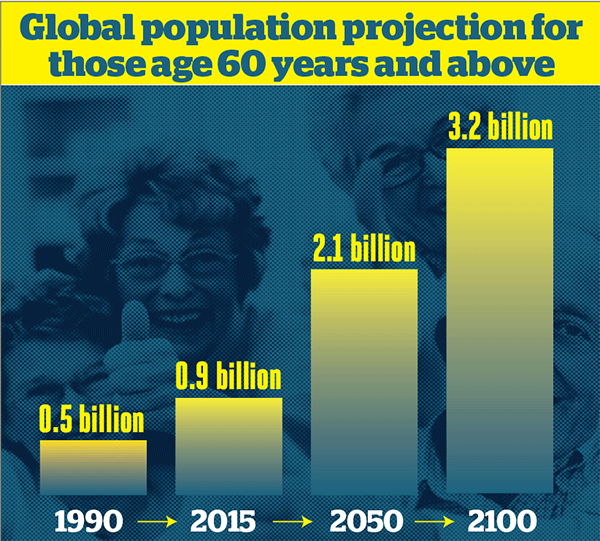Funds and trusts to profit from a rapidly ageing population
19th October 2018 09:46
by David Prosser from interactive investor
Share on
What are the familiar and less obvious ways for investors to make money from demographic change? David Prosser has the answers.

Danica May Camacho grabbed her 15 minutes of fame early. On her birth, on 31 October 2011 in Manila, Danica was officially anointed the world's seven billionth person – a human moment in a story of demographic change that is usually told through statistics.
Not that the numbers lack drama. By the time Danica celebrates her seventh birthday, the world population will have risen by another 600 million. The UN expects the population to hit eight billion in 2024 and keep growing – to 9.8 billion by 2050 and 11.2 billion by 2100.
It's not just that there are more of us. The global population as a whole is getting older. The World Health Organisation estimates that the proportion of the world's population aged above 60 will rise from 12% to 22% between 2015 and 2050. And 80% of older people will be living in low- and middle-income countries by 2050.
"Ageing populations are now a phenomenon across both developed and emerging markets, and the trend is accelerating," argues Taimur Hyat, chief strategy officer at US investment firm PGIM and author of 'Silver Lining', a report on the investment implications of demographic change. "Investors should consider capitalising on the opportunities arising from this unprecedented global demographic shift," he adds.
In which case, where should investors look for returns? Demographic change is a central pillar of the conventional case for emerging market investment. These countries tend to have faster-growing populations and should grow more rapidly as their workforces expand.
This is true, but the reality is more nuanced. To maximise economic advantage, what countries need most is increasing numbers of working-age people relative to those who are economically unproductive. In these countries, citizens will be able to consume, save and invest more.
Analysis by Allianz Global Investors, however, suggests this demographic dividend varies greatly from one emerging market to the next. In Africa and India the ratio of working-age people to the total population will be 11% and 5% respectively higher by 2050. But in Latin America, and especially Brazil, where the population is older, the ratio will fall by modest amounts. In China, one effect of the one-child policy enforced until 2015 is that the ratio is likely to decline by more than 15% over the next three decades.
On this basis, the demographic argument for investment is strongest in Africa and India, but much weaker in markets that investors have often been most excited about.

Healthcare needs
More people equals more demand for healthcare and medicines, so the 30% global population growth projected for the next 40 years should automatically boost businesses in this sector. But there are two additional reasons to be bullish.
First, as standards of living improve worldwide, so will the quality of healthcare people demand. In 2011, the World Health Organisation says, annual US spending on healthcare was around $8,000 per person (£6,157). By contrast, China and India spent just $265 and $122 respectively. As the wealth of these countries increases, the gap will close, supercharging growth in the healthcare industry.
Second, ageing populations consume more healthcare, with older people requiring more prescription drugs and medical interventions. The older populations of developed economies are an exciting proposition for healthcare businesses, but this factor is significant everywhere. In Asia, for example, pensioners account for 6% of the population, but this will rise to 17% by 2050.
"As longevity increases and the proportion of retirees rises, we expect to see substantial growth in healthcare spending," says Paula Campbell Roberts, director of the global macro and asset allocation team at investment firm KKR . "Amid rising costs and strapped government budgets as well as an increased focus on self-care, lower-cost approaches to healthcare and personal healthcare management solutions will increase in popularity."
Changing finances
Older people tend to be wealthier than their younger counterparts, but their needs are also very often more complex. For example, property represents around 40% of the assets of older people in developed markets, according to analysis from consultant PwC. However, the property needs of older people may change: they're more likely to look for second homes, homeworking locations and, later in life, retirement communities and nursing homes. Investment opportunities in these areas may therefore be attractive.
Equally, many older people may unlock property wealth to supplement their income. We may see an increase in people downsizing later in life, while sales of equity release products are likely to rise.
Elsewhere in the financial services market, the scramble to capture the retirement planning market – both savers accumulating assets for later in life and those looking for products to 'decumulate' once they reach retirement – is increasingly frenetic all around the world.
Data from Willis Towers Watson shows that global institutional pension fund assets in 22 major markets totalled $41.3 trillion at the end of 2017, having grown at 6% a year for the previous two decades. The race is on to find new solutions for retirement planning fit for the new demographics. "Challenges lie ahead for funds worldwide," says Roger Urwin, head of investment content at the firm. "Countries with ageing populations will need to accommodate increased benefit payments."
Rising demand
All the extra demand created by population increases and economic growth must flow back through the supply chain, requiring additional raw materials. But there's a double whammy effect here: as people's wealth increases, their consumption tends to drive more intensive use of commodities and energy.
In China, for example, the consumption of aluminium, copper and steel per head has tripled over the past decade. Other developing countries have seen similar trends. Similarly, according to the World Energy Council, global demand for energy will rise by 45% by 2050.
For businesses and industries charged with meeting this demand, from mining to wind power, the outlook – increasing demand and higher prices, particularly for more scarce commodities – could hardly be brighter. Many sectors will benefit, but the biggest winners are likely to reflect climate change-related drivers.
The World Energy Council expects renewable energy to increase its share of global power generation from 7% today to 30% over the next three decades. More broadly, all economic growth will have to be underpinned by a drive to manage resources more effectively. Enthusiasm for car-sharing and autonomous vehicles in the automotive industry is just one example of this idea.
"Efficiency improvements are vital if we are to achieve economic growth while keeping carbon emissions within recommended levels," says Hamish Chamberlayne, a portfolio manager in Janus Henderson's sustainable and responsible investment team. "Changes will not just be needed in the industrial and transportation sectors. Residential and commercial buildings are the largest and most inefficient users of energy globally."
Infrastructure will be an important part of this story. We must manage water resources more carefully, for example, while improving health. The OECD thinks investment in water facilities alone will total $600 billion a year for the next 20 years as we try to increase the number of people with access to clean water and sanitary facilities, currently at 83% and 58% respectively.
Funds to benefit from an ageing population
For a single bet on the ageing global population theme, the London-listed iShares Ageing Population ETF tracks the performance of an index of developed and emerging market stocks generating revenues from the needs of people age 60 or over. Financial services and healthcare dominate its holdings. The fund has returned a little over 20% since its launch in September 2016.
An alternative is funds with exposure to one or more of the sectors that stand to benefit from the ageing of the global population.
Jason Hollands, managing director at wealth manager Tilney, says: "F&C Responsible Global Equity is positioned across several of these areas. It applies environmental screening as part of its process and has high exposure to financials and healthcare." Sector-specific plays he likes include AXA Framlington Health, Jupiter Financial Opportunities and Investec Enhanced Natural Resources.
Darius McDermott, managing director at Chelsea Financial Services, tips Polar Capital Healthcare Opportunities, Barings Global Agriculture and the environmental specialist EdenTree Amity UK. "It's also worth looking at Target Healthcare REIT and Impact Healthcare REIT, which invest in late-living accommodation," he says.
Full performance can be found on the company or index summary page on the interactive investor website. Simply click on the company's or index name highlighted in the article.
This article was originally published in our sister magazine Money Observer, which ceased publication in August 2020.
These articles are provided for information purposes only. Occasionally, an opinion about whether to buy or sell a specific investment may be provided by third parties. The content is not intended to be a personal recommendation to buy or sell any financial instrument or product, or to adopt any investment strategy as it is not provided based on an assessment of your investing knowledge and experience, your financial situation or your investment objectives. The value of your investments, and the income derived from them, may go down as well as up. You may not get back all the money that you invest. The investments referred to in this article may not be suitable for all investors, and if in doubt, an investor should seek advice from a qualified investment adviser.
Full performance can be found on the company or index summary page on the interactive investor website. Simply click on the company's or index name highlighted in the article.
These articles are provided for information purposes only. Occasionally, an opinion about whether to buy or sell a specific investment may be provided by third parties. The content is not intended to be a personal recommendation to buy or sell any financial instrument or product, or to adopt any investment strategy as it is not provided based on an assessment of your investing knowledge and experience, your financial situation or your investment objectives. The value of your investments, and the income derived from them, may go down as well as up. You may not get back all the money that you invest. The investments referred to in this article may not be suitable for all investors, and if in doubt, an investor should seek advice from a qualified investment adviser.
Full performance can be found on the company or index summary page on the interactive investor website. Simply click on the company's or index name highlighted in the article.